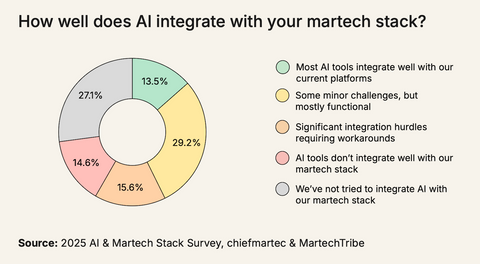Marketing is no longer merely assisted by AI — it is increasingly built with AI. Beyond occasional prompts, teams are now connecting models to unstructured data (calls, emails, chats), injecting summaries and enrichments directly into CRM/CDP systems, and orchestrating decision-making workflows capable of recommending — and sometimes even acting.
This shift moves the center of gravity of marketing: value no longer lies in isolated tools, but in integration — data quality, stack interoperability, governance, and feedback loops that continuously enhance campaigns and customer journeys. Preconceived notions are giving way to measurable disparities: some B2B organizations are integrating faster than B2C, not because of superior “technology,” but because their processes, volumes, and architectures are more conducive to it.
The real challenge now is to industrialize AI where it delivers measurable advantage: extracting actionable signals from the voice of the customer, scaling personalization without breaking brand consistency, and automating without losing control. Only then does AI evolve from gadget to structural driver of marketing performance.
1. Current State: AI Assistants Widely Adopted

“Stand-alone” AI assistants are now extensively used within marketing teams. According to the study conducted by Scott Brinker for chiefmartec (“Beyond AI Assistants: How AI Is Being More Deeply Embedded in Marketing and Martech Stacks”), based on a survey of 96 marketing operations and martech leaders, 87.5% report that these tools are now “widely used.”
In other words, the adoption phase of AI assistants has largely been completed. The next question is: to what extent are these AIs integrated into the broader marketing technology ecosystem? AI assistants remain useful — but are they still peripheral tools, or are they now embedded within processes, data, and platforms? That’s the central issue this article explores.
2. From Peripheral Tools to Full Martech Stack Integration
2.1 Integration Rates
A key finding: only 42.7% of respondents report that AI tools integrate well — or with only minor challenges — into their existing martech stack.
The study reveals a striking divide between B2B and B2C sectors:
-
54% of B2B companies report easy integration.
-
Only 15.4% of B2C companies report the same.

This reverses the traditional stereotype that B2C firms lead martech adoption. It suggests instead that AI integration hurdles are higher in B2C contexts (due to scale, multichannel complexity, and speed of change) than in B2B environments, where processes tend to be more structured.
2.2 Leveraging Unstructured Data
The study highlights a major shift: AI is no longer limited to structured data (CRM, spreadsheets, databases). It increasingly processes unstructured data: phone calls, emails, chat logs, transcripts, and even web scraping.
Key figures:
-
65.6% of respondents use AI to capture, analyze, and leverage unstructured customer data.
-
Main data sources include: call recordings/transcriptions (~41.7%), emails (~26%), and chatbots (~26%).
-
15.6% use website scraping of client/prospect data to derive insights.

This expansion into unstructured data is pivotal — it unlocks the potential of “customer voice” and conversational data that were previously inaccessible or underexploited.
2.3 LLM-Based Workflows and Automation
One of the most forward-looking findings concerns the integration of large language models (LLMs) into automated workflows. The results:
-
68.7% of companies already have at least one LLM-based workflow or automation in production.
Top use cases include:
-
Summarizing messages or content: 38.5%
-
Personalizing messages or content: 31.3%
-
Translating messages or content: 22.9%
-
Enriching prospect/client profiles: 25% (especially in B2B)
-
Automated decision-making or recommendations (“agentic workflows”): 20.8%

This last case — agentic workflows — is worth monitoring closely: it marks the point where AI stops merely assisting and starts recommending or deciding. The study notes, however, that this phase is still in its infancy and organizations are moving cautiously.
2.4 Platforms Used for AI Deployment
Finally, the study explored where AI automation is being deployed:
-
44.8% of respondents say AI automation is embedded within existing marketing SaaS platforms (CRM, MAP, DXP, CDP, etc.).
-
~19.8% use iPaaS or workflow orchestration platforms.
-
~18.8% rely on in-house AI development.
-
8.3% use “AI-native agentic platforms” (e.g., CrewAI, Relevance AI, etc.).

These results show that most companies are not overhauling their martech infrastructure. Instead, they prefer embedding AI within their existing tools rather than adopting new, fully AI-native platforms. This is a strong signal for strategic decision-making.
3. Critical Analysis — Implications, Opportunities, and Limitations
3.1 Strategic Implications
a) The Data Value Chain Is Becoming More Complex
Connecting AI to unstructured data changes the game. Until now, marketing relied primarily on CRM databases, segmented profiles, and targeted campaigns. AI now enables insight extraction from conversational interactions (calls, chats) or even proactive actions (web scraping). This means:
-
Increased value for the voice of the customer and human interactions within marketing data.
-
Richer profiling — not just what a customer does, but what they say, ask, and implicitly seek.
-
Greater need for data governance (quality, consent, anonymization) and architecture that links structured and unstructured sources.
b) Marketing Is Evolving Toward “AI-Augmented” Roles
Most AI use cases are augmentative: summarizing, personalizing, translating. They free marketers from repetitive, time-consuming tasks so they can focus on higher-value activities. For digital marketing professionals, this opens up:
-
More time for strategy rather than execution.
-
The ability to offer differentiated services (multilingual adaptation, real-time personalization).
-
Skill development around AI as a creative and strategic lever rather than a gimmick.
c) Gradual Shift Toward Autonomous Workflows
“Agentic workflows” (AI recommending or deciding) are still a minority (~20%) but represent the next frontier. Two implications emerge:
-
Progress must be gradual — test, measure, identify limits, and manage risk.
-
Ethics, transparency, and quality control become central: when AI decides or recommends, who verifies? What error rate is acceptable? How is brand consistency maintained? Human supervision must remain strong during this transition phase.
3.2 Risks and Safeguards
-
Data Quality & Governance: Poorly managed unstructured data can lead to bias or misinterpretation.
-
Technical Integration: With only 42.7% reporting smooth integration, barriers remain significant.
-
Overestimating AI: The study stresses that “agentic” AI remains limited — it’s an augmentation tool, not a miracle solution.
-
Cultural & Skill Shifts: AI transforms, but does not replace, marketers. Upskilling and change management are essential.
-
Ethics & Trust: As AI takes on more decision-making, compliance (GDPR, consent, traceability) and trust-building become critical.
4. Successfully Integrating AI Into Your Martech Stack
Step 1: Audit & Map Your Stack and Data
-
Inventory all martech platforms (CRM, MAP, CDP, DXP, iPaaS, etc.).
-
Map data sources — structured (CRM, transactions) and unstructured (calls, emails, chat logs, web interactions, forums). Assess quality, access, and storage.
-
Evaluate your current AI integration (assistants, automated workflows, LLMs).
-
Identify marketing goals (personalization, multilingual capabilities, productivity, conversion, satisfaction).
-
Note technical, human, and budget constraints and define success KPIs.
Step 2: Select Pragmatic AI Use Cases
Based on the study’s findings, prioritize quick-win, high-value, low-risk cases:
-
Automatic summarization of messages or call transcripts.
-
Personalized content generation via AI + customer data.
-
Translation and multilingual adaptation (already widely used).
-
Prospect/customer profile enrichment (leveraging unstructured data + web scraping).
Then, as maturity grows, move toward:
-
Agentic workflows (content recommendations, automated triggers, semi-autonomous decision-making).
-
AI-based campaign automation (budget allocation, real-time optimization, acquisition).
Step 3: Integrate and Configure
-
Choose tools that extend your existing stack (CRM/MAP/CDP) — this is the most common and efficient approach (44.8%).
-
Set up data interfaces: extract unstructured data, pre-process (transcription, cleaning), feed AI, and reinject results into marketing systems.
-
Build automated workflows (e.g., if an email or transcript contains specific keywords, summarize and route to sales).
-
Define human vs. AI responsibilities: who supervises, validates, and monitors autonomy levels.
-
Measure and optimize continuously (time saved, engagement rates, conversion, relevance of recommendations).
Step 4: Governance, Maturity, and Culture
-
Implement AI governance: rights management, transparency, traceability, bias mitigation, privacy compliance.
-
Train marketing teams to use and interpret AI responsibly.
-
Promote a “Human + AI” culture — AI is an amplifier, not a replacement. Encourage experimentation and continuous learning.
-
As maturity increases, move toward agentic workflows, closed-loop learning, and AI-augmented decision-making.
-
Maintain continuous technological watch — as the article reminds, we’re still in the first half of AI’s martech evolution.
Conclusion
Scott Brinker’s analysis highlights a major turning point in marketing technology: AI is no longer just an assistant — it is becoming a structural component of martech stacks, embedded in data, workflows, and platforms.
For marketing and digital communication professionals, the opportunity is to embrace this transition strategically and methodically.
The future belongs to AI-augmented marketing. The first battles — adoption of AI assistants — have already been won. The next one, deep integration within the martech stack, is being fought now. Seize it.
FAQ: AI & Marketing
Q1. What is a “martech stack,” and why is integrating AI important?
A martech stack is the full set of platforms, tools, and workflows used in marketing (CRM, MAP, CDP, DXP, iPaaS, etc.). Integrating AI enables marketers to:
-
Process a broader variety of data at scale, especially unstructured data.
-
Automate complex workflows (summarization, personalization, optimization).
-
Align technology and intelligence for more efficient, measurable, and coherent marketing actions.
Q2. Why is unstructured data (calls, emails, chat logs) so important?
Such data has long been a “gray zone” for marketing — rich in insights (intent, frustrations, expectations) but hard to process at scale. Thanks to LLMs and AI methods, 65.6% of companies now capture, analyze, and leverage it. This helps refine understanding, improve targeting, and personalize experiences.
Q3. What are the main use cases of AI in marketing workflows?
According to the study:
-
Summarizing messages/content: 38.5%
-
Personalizing messages/content: 31.3%
-
Translating messages/content: 22.9%
-
Enriching profiles: 25%
An emerging use: agentic workflows (autonomous decision/recommendation) in 20.8% of companies.
Q4. Why is AI integration higher in B2B than in B2C?
54% of B2B firms report easy integration, versus 15.4% of B2C firms. Likely reasons: B2B processes are more standardized, data volumes smaller but more qualified, and Account-Based Marketing (ABM) models suit AI-driven workflows. B2C organizations face greater fragmentation, speed, and multichannel complexity.
Q5. Do you need to rebuild your entire martech stack to adopt AI?
No. Most companies (44.8%) deploy AI automation within their existing SaaS platforms (CRM, MAP, CDP).
Two main strategies:
-
Extend current systems with AI modules or plug-ins.
-
Build or integrate AI-native or in-house platforms (still less common).
In most cases, the pragmatic route is enhancing what exists rather than starting from scratch.
Q6. What risks or limitations should marketers consider before adopting AI?
-
Poor data quality: AI can’t fix flawed or unstructured data.
-
Complex or costly integration: Only ~42.7% report smooth implementation.
-
Overestimating AI autonomy: Agentic workflows are still emerging.
-
Human skills and culture: AI transforms roles — training and adaptation are key.
-
Ethics and compliance: As AI takes more decisions, human oversight, legal conformity, and transparency become critical.
Ethics, transparency, and compliance: the more decisions AI makes, the greater the human, legal, and trust-related challenges become.





